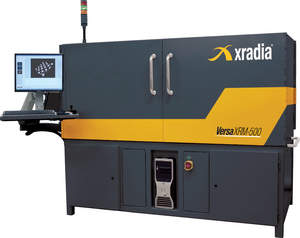Xradia, the world's leading manufacturer of 3D X-ray microscopes for the lab and synchrotron, announced today that The University of Manchester has purchased the VersaXRM-500 3D X-ray microscope with funding from The Engineering and Physical Science Research Council for use in its advanced imaging laboratory.
 VersaXRM-500 3D X-ray microscope providing true submicron spatial resolution < 700 nm
VersaXRM-500 3D X-ray microscope providing true submicron spatial resolution < 700 nm
Manchester selected the XRM to better understand the evolution of structure over time (the fourth dimension), under varying conditions and in a wide range of scales. In particular the VersaXRM will track temporal changes at submicron scales on materials from biomaterials to new energy solutions.
Professor Philip J. Withers, Co-director of the Manchester X-ray Imaging Facility, says he has one of the most exciting jobs in the world: studying mites on the back of a 49-million-year-old spider before examining an optic nerve, then following the internal workings of a lithium battery as it charges and discharges, before getting to grips with the accumulation of damage in a carbon fiber composite. Located within The Faculty of Engineering and Physical Sciences, this busy lab, currently with more than 150 users, serves 30 companies, 30 universities and a large number of visitors each year. The faster-time-to-information provided by the VersaXRM will enable the lab to expand its reach even further, and to continue to form partnerships such as its new relationship with BP, for which it performs studies on energy materials. Professor Withers expects the system to be used 24/7.
The Xradia VersaXRM has a number of unique capabilities, in particular the ability to maintain high resolution over a large working distance that allows the insertion of complex in situ stages while maintaining optical performance. The laboratory microscope achieves true submicron spatial resolution below 700 nm, extending beyond even many synchrotron microCT beam lines, with selectable voxel resolution less than 150nm. The VersaXRM also provides unique contrast tunability, a combination of advanced absorption and phase contrast, which enables visibility of a much wider range of unstained and low Z materials such as biological samples and fossils. Additionally, the non-destructive nature of X-rays enables repeated study of the same sample in situ under a variety of conditions, including thermal excursions, tension, compression, desiccation, hydration, etc.
According to Professor Withers, "The main reason we chose Xradia is because of the unique optics in their systems, especially the VersaXRM, which allows us to get very high resolution 3D images in a much larger working space, necessary for the various rigs and furnaces used in our in situ research. It's no good quoting high resolution if your sample must be 2mm from the X-ray source. This capability alone will enable us to study a broader range of materials, and over a period of time, providing valuable information to people who have come to rely on our lab for understanding the impact of real world conditions on their materials."
Projects for which Manchester will use the VersaXRM include using digital image correlation to map the deformation from one 3D image to the next 3D image to study novel auxetic (negative Poisson's ratio) materials, such as cork and foam. They will also use the VersaXRM to help identify certain fossil records, which may provide more information about evolution and environmental conditions. Manchester is also studying new fuel cells and batteries in situ to understand how they degrade in order to achieve better lifetimes, for which the VersaXRM's capabilities will prove invaluable.
Professor Withers notes, "There is a lot of science yet to be done at the micron scale, especially in quantifying the evolution of 3D microstructure in the materials sciences. With improved resolution and lower signal-to-noise ratio from the Versa, there are all sorts of things we can study that we struggled to study before."
Rod Browning, president and CEO of Xradia, says, "We are excited to begin this next phase of work with Manchester. Collaboration with the university over the past four years has helped us to understand important requirements for advanced studies in materials, life, and geological sciences, especially with the size and weights of materials used in their research. We look forward to this next stage of our relationship."
The VersaXRM-500 will be Manchester's third Xradia system. Originally impressed with Xradia's synchrotron heritage and its ability to leverage that background to provide superior optics, the University previously installed Xradia's earlier micro and nano systems.
The University of Manchester is a public research university located in Manchester, United Kingdom. It was formed in October 2004 by the merger of the Victoria University of Manchester (established in 1851) and the University of Manchester Institute of Science and Technology (established in 1824).The University of Manchester and its antecedent institutions have 25 Nobel Laureates among their past and present students and staff, the third-highest number of any single university in the United Kingdom (after Cambridge and Oxford).